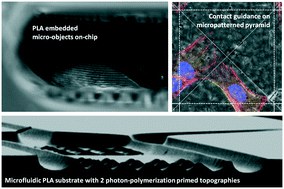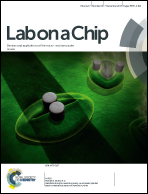Development of a microfluidic platform integrating high-resolution microstructured biomaterials to study cell–material interactions†
Abstract
Microfluidic screening platforms offer new possibilities for performing in vitro cell-based assays with higher throughput and in a setting that has the potential to closely mimic the physiological microenvironment. Integrating functional biomaterials into such platforms is a promising approach to obtain a deeper insight into the interactions occurring at the cell–material interface. The success of such an approach is, however, largely dependent on the ability to miniaturize the biomaterials as well as on the choice of the assay used to study the cell–material interactions. In this work, we developed a microfluidic device, the main component of which is made of a widely used biocompatible polymer, polylactic acid (PLA). This device enabled cell culture under different fluidic regimes, including perfusion and diffusion. Through a combination of photolithography, two-photon polymerization and hot embossing, it was possible to microstructure the surface of the cell culture chamber of the device with highly defined geometrical features. Furthermore, using pyramids with different heights and wall microtopographies as an example, adhesion, morphology and distribution of human MG63 osteosarcoma cells were studied. The results showed that both the height of the topographical features and the microstructural properties of their walls affected cell spreading and distribution. This proof-of-concept study shows that the platform developed here is a useful tool for studying interactions between cells and clinically relevant biomaterials under controlled fluidic regimes.



 Please wait while we load your content...
Please wait while we load your content...